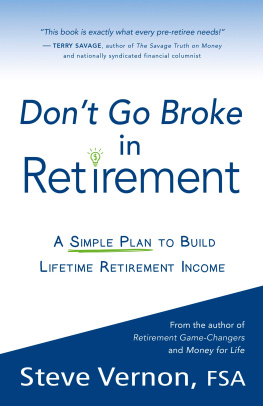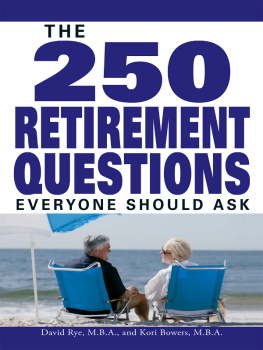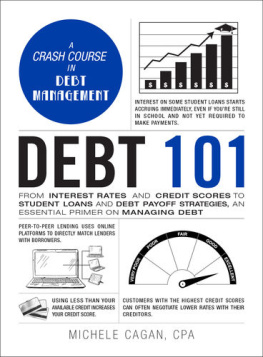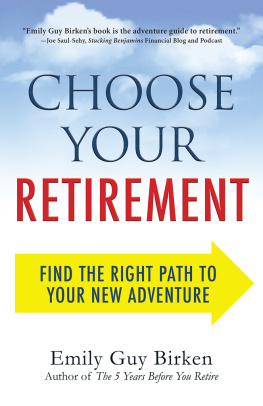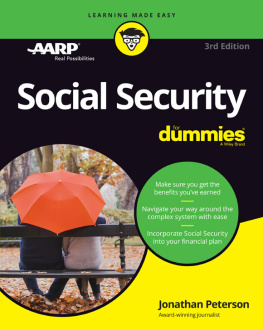Contents
Guide
Pensionless
The 10-Step Solution for a Stress-Free Retirement
Emily Brandon

Avon, Massachusetts
To Charlotte and Peter
Introduction
Most of us want to eventually stop working and begin enjoying a well-deserved retirement. The problem lies in how to pay for it. We typically have enough trouble covering our monthly bills, let alone funding a twenty- or thirty-year period of leisure. In years past, our employers helped solve the problem. Many companies provided a pension that offered a significant source of income during retirement. Today, thats seldom the case. Most employers no longer offer traditional pension plans, which is a major change from the generation who came before us. In place of these vanished pensions, we must piece together a retirement income from a variety of sources. Our retirement plan is built out of a combination of Social Security, Medicare, and money saved for retirement, typically in a 401(k) or IRA.
The Golden Age of Pensions
It wasnt always this way. In 1980, about 39 percent of the labor force had a traditional pension plan, according to Department of Labor data. The number of traditional pension plans peaked in 1983 at more than 175,000. These pensions provided retirement security for millions of workers. With a pension plan, once you meet the appropriate age and number of years on the job, you can retire knowing that your former employer will provide you monthly payments from your retirement date onward. In most cases, these payments continue for the rest of your life.
While less than half of workers were ever fortunate enough to have a pension, those who did have one could retire with a steady stream of monthly payments in addition to Social Security and their personal savings. The plan sponsor often hired an investment expert to manage plan assets, and no investment knowledge on the part of the employee was required. The federal government even insured most private-sector pension plans and paid out benefits up to certain annual limits if the plan failed.
Alas, few of us today will ever experience the retirement security such pensions provide. The proportion of people with traditional pensions has fallen relentlessly since 1980. By 2012 there were fewer than 44,000 traditional pension plans left, and the number has continued to drop. Almost all of us are now pensionless. In their place, the 401(k) plan has risen as the new predominant workplace retirement benefit. As of 2015 some 61 percent of private industry workers had the option to participate in a 401(k) plan or similar type of workplace retirement account. However, only 43 percent of employees actually used the plan.
401(k)s: The New Retirement Standard
In contrast to pension plans, you bear nearly all of the risk associated with your 401(k) plan, and your ability to retire comfortably suffers if you underuse the account. You and your employer must each decide how much to deposit in the account. You must also select investments that will build wealth for the future while also avoiding losses. Often the only investment training you will receive is a one-hour seminar provided by the 401(k) plan sponsor about how the account works.
The benefits of a 401(k) plan depend on your ability to save consistently, invest prudently, and make it through a gauntlet of fees and penalties. When you change jobs or retire, you will also need to familiarize yourself with individual retirement accounts to maintain the tax benefits of your 401(k) plan. How well you are able to use these retirement accounts, and avoid the taxes and penalties associated with them, will ultimately determine your retirement lifestyle.
Using What Youve Got
While you may never receive a traditional pension from a former employer, there is a lot you can do to make the best of the retirement benefits you do have. This book will walk you through ten steps that will improve your retirement finances. You can boost your financial situation, even on the verge of retirement, by strategically securing more money from Social Security and getting your employer to help pay for retirement. There are also a variety of tax deductions and credits available to retirement savers that can help you grow your money faster.
Retirement planning problems often arise when you dont know all the rules and conditions associated with the various types of retirement benefits. Many retirement benefits have both age-related and calendar-year deadlines, and the penalties for missing them can be severe. Its important to know how to avoid surcharges on your Medicare benefits and fees on your 401(k) and many other rules and gotchas that have the potential to trip you up as you prepare for retirement. Successfully avoiding fees and penalties can help you minimize costs and boost the value of your retirement benefits.
Your retirement security depends on your ability to use each type of retirement benefit. Those who know how to get more money from Social Security and pay less in taxes may be able to enjoy a higher retirement income than people who are unfamiliar with these strategies. Its worth the time to learn how to make optimum use of your retirement benefits. The deck is stacked against you, but you can still play your best hand.
Step 1
Maximize Social Security
Social Security is the foundation on which your retirement finances are built. Most people pay into the system beginning with their first paycheck and begin to collect payments in their sixties. Benefits are calculated based on the amount you have paid in and when you choose to start receiving benefits ( www.ssa.gov/retire/apply.html ).
Though the benefits are typically modest, they are an important source of retirement income because they are guaranteed to last for the rest of your life no matter how long you live. Furthermore, they are adjusted for inflation each year, so they wont lose value over time. For many people, and especially those facing retirement without traditional pensions, Social Security is the only source of retirement income that provides these guarantees.
The vast majority of those who are retired (86 percent) receive income from Social Security. The program provides at least half of the retirement income of 65 percent of retirees, and more than a third receive 90 percent or more of their retirement income from Social Security payments.
The Origins of Social Security
The Social Security program was created in 1935 by President Franklin Roosevelt. Workers began to pay into the system in 1937, and monthly benefits were distributed starting in 1940. The initial contribution amount was 1 percent. The payroll tax has been gradually increased over several decades, first hitting 3 percent in 1960 and 5 percent in 1978. The current tax rate of 6.2 percent has been in effect since 1990. The original Social Security Act promised benefit payments that ranged from $10 to $85 per month. The first monthly retirement payment was issued to sixty-five-year-old Ida May Fuller of Ludlow, Vermont, for $22.54. During Fullers lifetime Social Security payments to retirees could be increased only by special acts of Congress. Automatic cost-of-living adjustments for retirees were added to the Social Security program in 1972 and paid out beginning in 1975.
In 2014 the average Social Security payment to retired workers was $1,294 per montha big jump from the payout to Ida May Fuller (the first recipient of Social Security), but still small relative to todays living expenses. Retired couples in 2014 received an average of $2,111. However, this payment varies considerably by individual and is significantly influenced by three important factors:


